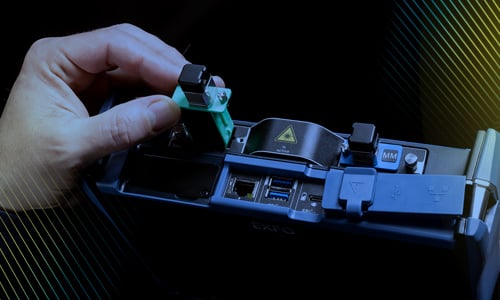Transforming networks to deliver more bandwidth
Eric Honig, EXFO’s Director, Access and Platform Ecosystem Business Units, recently participated in a podcast hosted by ISE Magazine (formerly OSP Magazine).
Subscribers have an ever-growing need for more bandwidth. Eric discussed the challenges service providers are facing within that environment; the latest technologies being deployed; and testing practices that are critical to successfully installing and deploying these new technologies and networks.
Access Eric’s podcast here or read on for a detailed summary of his main discussion points.
Service providers face big choices and challenges
- The ultimate challenge is how to deploy high-speed broadband services rapidly coupled with a high return on investment (ROI).
- From an access network perspective, service providers face a choice: deploy fiber-to-the-home (FTTH) or enhance existing infrastructure with a combination of fiber and copper loop plant.
- FTTH is seen as the ultimate end-goal for many global service providers, but deployment costs & time are key factors to consider with fiber deployments.
Technology choice is dependent upon both current infrastructure and future service potential.
There are several new technologies available, each with their own business drivers. They can be divided up between copper-based and fiber-based.
Copper-based technologies, including VDSL2 vectoring and Gfast, makes sense when the copper infrastructure is already in place.
VDSL2 vectoring
- Vectoring is all about noise cancellation. It was introduced to mitigate the reduction in VDSL2 data rates caused by far-end crosstalk (FEXT) and supports subscriber data rates in the range of 100 Mbit/s.
- Architecture: VDSL2 vectoring leverages a fiber-to-the-node (FTTN) infrastructure, where the optical fiber connection is fed to a remote DSLAM typically within 3000 ft of the customer premise.
- The main business drivers are time to market and lower cost. With VDSL2 vectoring many service providers can deliver higher speeds at about 1/3 the cost of deploying fiber, and in a fraction of the time.
Gfast
- A relatively new technology, Gfast targets aggregate data rate speeds up to 1 Gbit/s, depending on loop length and configuration.
- Architecture: Gfast leverages a fiber-to-the-distribution point (FTTdp) infrastructure. It extends the fiber to within 1000 ft of the customer premise to a distribution point unit (DPU) to serve only a handful of customers.
- The main business drivers include CAPEX reduction and higher speeds. Gfast enables a reduction in CAPEX by deferring the cost of extending fiber to every building and home. Subscribers get fiber-like speeds over the last distance of existing copper infrastructure.
Fiber-based technologies are the best choice for greenfield areas as well as strategic locations where deployments can be cost-justified given the potential for higher service revenue.
FTTH
- Fiber-to-the-home installations completely by-pass the copper infrastructure—GPON being the most common in the telco space.
- The business drivers of FTTH are three-fold: maximize average revenue per user (ARPU); enable the ability to offer premium services; enhance the end-user experience; and ultimately build a competitive advantage.
In all the cases mentioned above—whether copper or fiber—new deployments will occur. As a result, testing of the physical layer as well as service validation will be required. It is vital to establish best testing practices for each phase in order to achieve expected data rates and reliability while minimizing costly and time-consuming troubleshooting efforts.
Best-practice testing is crucial when deploying new networks.
To ensure deployment success for both optical and twisted-pair copper networks, specific steps should be followed.
For optical distribution networks:
Step one: Perform testing at every deployment phase to make sure that the new optical component is correctly installed. These tests may range from a simple connector endface inspection or an optical power measurement to more advanced qualification such as optical time domain reflectometer (OTDR) testing.
- One of the most important factors in ensuring proper transmission over fiber is controlling power loss in the network against the link-loss budget specifications from the network design recommendations.
- Fiber inspection and cleaning is a must. Dirty connectors remain the # 1 cause of faulty fiber connections.
Step two: Establish testing methods of procedure (MOPs) that include all the steps needed to deploy the fiber and ensure compliance across field teams.
For twisted pair copper networks:
Step one: Physical measurements such as stress balance, impulse noise, resistive fault location (RFL), and time domain reflectometer (TDR) are just a few measurements that are key to detecting and locating copper faults during the installation and repair phases.
Step two: Automated Gfast (or VDSL2) closeout tests are necessary to validate subscriber data rates and performance.
Step three: It is important to validate the real throughput of a circuit using a trusted method for testing speed, preferably one that subscribers themselves are familiar with, such as Speedtest® by Ookla®. Further validation of services such as IPTV and VoIP are required to ensure there are no issues.
Field process automation is a requirement for all networks
Critical to the successful deployment of any type of network is field process automation. It streamlines and automates complex testing procedures during both the construction and turn-up phases and delivers key benefits including:
- Leverages software intelligence to ensure compliance: conduct the right tests, with the right thresholds in the right sequence—and get automatic test-data upload.
- Ensures deployment efficiency: guide field tech’s through the testing process— reducing overall testing time up to 50% in the process.
- Delivers confidence in network quality and 100% first-time-right builds—only pass results are accepted.
As well, improving visibility of the test data, with the ability to dashboard benchmark performance indicators such as network quality and job progress and contractor efficiency, is critical. It’s not enough to simply capture data, but there must be a way to visualize it to easily see the important network and systems information that it carries.
Ookla and Speedtest are registered trademarks of Ookla




